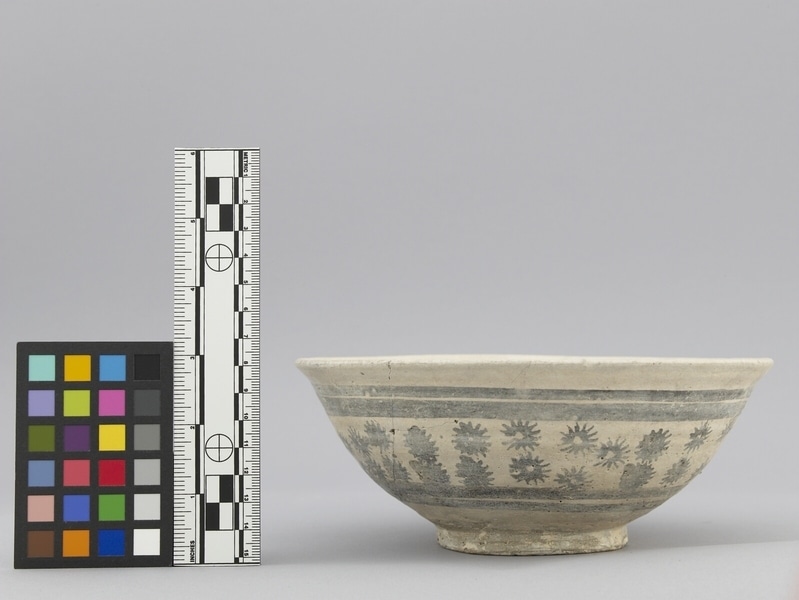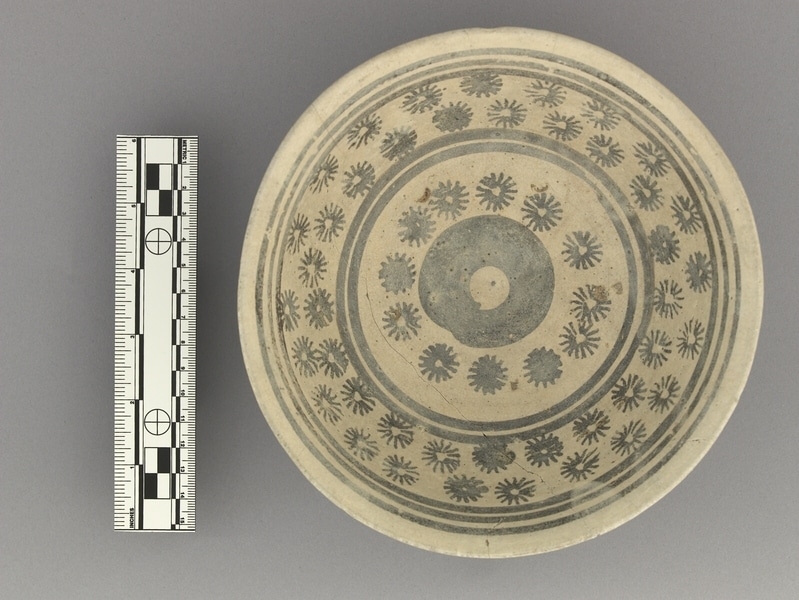Bowl Item Number: Ed1.286 from the MOA: University of British Columbia



Description
Stoneware bowl (chām; ชามl) with slip and painted decoration under the glaze. The sides curve up from the foot, flaring sharply to an everted lip; foot and base unglazed; body, coarse medium grey stoneware. Exterior: broad band of painted white slip, stamped with two rows of small sunburst motifs in blue, enclosed top and bottom with two broad bands of plain white slip. Interior: one broad band of plain white slip, surrounded by a band stamped with one row of stylized sunburst motifs, encloses plain centre at bottom; walls are the same as the exterior, except for triple bands of plain slip below the lip. The bottom surface of the interior exposes grey body between slipped bands.
History Of Use
Sangkhalok ceramic (สังคโลก) bowl. Thailand has produced a variety of potteries for thousands of years. The Sukhothai Kingdom (1238–1438) produced ceramics at kilns in two areas, near the city of Sukhothai and the city of Si Satchanalai, also known as Sawankhalok. The name Sangkhalok is said to derive from this name of the city. Production continued at these kilns even after the Sukhothai Kingdom was incorporated into the Ayutthaya Kingdom (1351– 1767) and continued through the end of this period. During the late fourteenth to the late sixteenth centuries, glazed and decorated wares were produced in several places in north central Thailand for export, and these wares have been found in the other parts of Southeast Asia, but also in Japan, likely from shipwrecks from this period
Specific Techniques
Stoneware with cream slip (mixture of clay and water) and a coating of fine clay, painted with the decoration under the glaze.
Iconographic Meaning
The sunburst designs are typical of Sukhothai wares.
Item History
- Made in Sukhothai, Thailand between 1500 and 1550
- Owned by Jean Fahrni before March 24, 1981
- Received from Jean Fahrni (Seller) and Fyfe-Smith Memorial Oriental Collection Fund (Funding source) on March 24, 1981
What
Who
- Culture
- Thai
- Previous Owner
- Jean Fahrni
- Received from
- Jean Fahrni (Seller) and Fyfe-Smith Memorial Oriental Collection Fund (Funding source)
Where
- Holding Institution
- MOA: University of British Columbia
- Made in
- Sukhothai, Thailand
When
- Creation Date
- between 1500 and 1550
- Ownership Date
- before March 24, 1981
- Acquisition Date
- on March 24, 1981
Other
- Item Classes
- ceramics
- Condition
- fair
- Accession Number
- 0707/0001